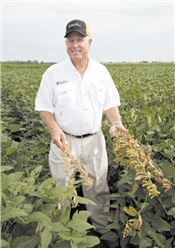|
High Oleic Soybean Oil Without Trans Fats

High oleic, non-genetically modified soybean oil can be grown without any trouble, explains Dr. Grover Shannon, University of Missouri plant sciences professor.
Photo by John LaRose, Jr.
Soybean Varieties High Oleic Without Hydrogenation
REGINA LAROSE
MidAmerica Farmer Grower
PORTAGEVILLE, MO.
Dr. Grover Shannon, University of Missouri plant sciences professor, says high oleic, non-genetically modified, soybean oil can be grown without any trouble.
Shannon explained the U.S. Food and Drug Administration announcement that trans fats are unsafe in food led researchers at the University of Missouri to create soybean oil that has no trans fat. In order to preserve soybean oil for cooking, a process called hydrogenation is used to make the oil suitable. Hydrogenation also creates trans fats.
“If we could raise the oleic in the soybean from 22 percent to 70 percent, we will not need to hydrogenate. It will be just like olive oil, healthier. We will have more uses; biodiesel, lubricates, cosmetics,” said Shannon.
Transgenic traits have been used to improve high oleic oil. What Shannon is working on at the University of Missouri is non-genetically modified high oleic soybean oil.
Using the germ plasm collection, Shannon began the search. “We took one gene that gave us 30 percent oil and another gene gave us 35 percent high oleic oil. When we put those two together we increased the oleic four fold. It went from 23 percent to over 80 percent.”
Yield was a major concern. “I don’t care if it’s a high oleic or whatever trait it’s got, if it doesn’t yield the farmers’ not going to plant it. We did studies to see if these high oleic soybeans were going to yield as good as what the farmer is normally growing. We found that there’s no yield drag from combining these two genes.”
Shannon stated Missouri is working on maturity group 3, 4 and 5. “We’ve checked some of our varieties and we’re trying to put disease resistance in these high oleic beans. We’re going to have soybeans that are going to compete with all the other commodity beans that farmers are growing. The first varieties released for high oleic from the University of Missouri will probably come out in an early late group 4 and early group 5.”
“One particular variety has good nematode resistance, we’re looking very hard and we’re increasing that seed. Some of the others that will follow will be in the group 4 and 3’s. Other states are taking these non GMO high oleic soybeans and they are going to be available to our U.S. farmers in every maturity group. He’s going to be able to choose whether it’s a group zero all the way to a group 7. Farmers are going to have a lot more options.”
Shannon said the result will be good yield, high oleic soybeans; conventional Roundup 1 and Roundup 2. “Hopefully, we’ll be able to put them into whatever trait that we’re able to breed with the different traits that other companies are working on with the various herbicide packages.”
Protein seems to be up at least two percent. “What this means is the farmer is going to have better meal for his cattle, he’s not going to have to blend it. It’s great for the cattle farmer, hog farmer and chicken farmer that need higher protein meal. A lot of these beans could produce as high as 50 percent meal without any trouble.”
Shannon added a look forward, “In the U.S., up to 30 million acres of high oleic beans; not only with good yield but with high protein content without very much reduction in oil.” ∆
REGINA LAROSE: Associate Editor, MidAmerica Farmer Grower
|
|